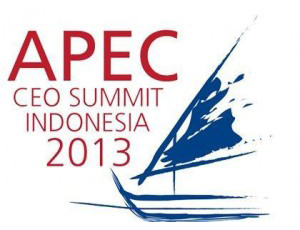Entire APEC region is on upward trajectory and assisting Chinese economic development
Op-Ed Commentary: Chris Devonshire-Ellis
 BALI, Oct. 9 – The IMF has stated that growth in APEC nations this year would be about 6.3 percent, and expand slightly to 6.6 percent in 2014. That’s roughly in line with the growth in China, which analysts have said that Chinese growth would be about 7 percent.
BALI, Oct. 9 – The IMF has stated that growth in APEC nations this year would be about 6.3 percent, and expand slightly to 6.6 percent in 2014. That’s roughly in line with the growth in China, which analysts have said that Chinese growth would be about 7 percent.
Within the APEC bloc are Australia, Canada, Chile, China, Hong Kong, Japan, South Korea, Mexico, New Zealand, Papua New Guinea, Peru, Russia, Taiwan, the United States and seven ASEAN members – Brunei, Indonesia, Malaysia, the Philippines, Singapore, Thailand and Vietnam. APEC in its entirety comprises about 55 percent of total world trade, meaning the performance of the bloc is critical to the world economy. It also emphasizes that Asia has truly become the world’s engine for growth.
Indonesian President Susilo Bambang Yudhoyono stated here in Bali, however, that “The 21 APEC members continue to feel the pain of the Global Economic Crisis. In view of the difficult economic situation, it becomes even more critical to work together in maintaining regional resilience.”
That is something that China has been doing by signing off on deals with Indonesia and Malaysia and suggestions an ASEAN Development Bank is formed to channel reserves from China’s Sovereign Wealth Fund into emerging Asia.
Much of the region is still highly connected to the Chinese economy, which is making the change from an export driven market to a consumer driven market – and one that will provide superb opportunities for Asia-based businesses to sell to China as the ASEAN Free Trade Agreement with China is due to fully kick in by 2015. That has meant that some emerging economies in APEC are doing better than others. APEC’s developing countries are expecting to see growth at 7.1 percent this year and 7.2 percent next year, slightly better than China. Of these, the Philippines has performed the best, with growth at over 7 percent this year. Moodys also just upgraded the Philippines to “investment grade.”
That said, the Chinese shift to a consumer based economy cannot take place overnight, and some patience needs to be exhibited. Overall, however, (barring any unforeseen disaster) trade within APEC and ASEAN especially is going to be brisk for the next decade, and foreign MNCs already in countries such as China should be looking at how to underpin that success by either branching out to sell to other developing Asian markets, or looking at how to reduce costs by manufacturing elsewhere in Asia while continuing to sell to China.
Chris Devonshire-Ellis is the Founding Partner of Dezan Shira & Associates – a specialist foreign direct investment practice providing corporate establishment, business advisory, tax advisory and compliance, accounting, payroll, due diligence and financial review services to multinationals investing in emerging Asia. Since its establishment in 1992, the firm has grown into one of Asia’s most versatile full-service consultancies with operational offices across China, Hong Kong, India, Singapore and Vietnam as well as liaison offices in Italy and the United States.
For further details or to contact the firm, please email china@dezshira.com, visit www.dezshira.com, or download the company brochure.
You can stay up to date with the latest business and investment trends across Asia by subscribing to Asia Briefing’s complimentary update service featuring news, commentary, guides, and multimedia resources.
Related Reading
 Are You Ready for ASEAN 2015?
Are You Ready for ASEAN 2015?
ASEAN integration in 2015, and the free trade agreements China has signed with ASEAN and its members states, will change the nature of China and Asia focused manufacturing and exports. In this important issue of Asia Briefing we discuss these developments and how they will impact upon China and the global supply chain.
 An Introduction to Tax Treaties Throughout Asia
An Introduction to Tax Treaties Throughout Asia
In this issue of Asia Briefing Magazine, we take a look at the various types of trade and tax treaties that exist between Asian nations. These include bilateral investment treaties, double taxation agreements, and free trade agreements – all of which directly affect businesses operating in Asia.
 An Introduction to Development Zones Across Asia
An Introduction to Development Zones Across Asia
In this issue of Asia Briefing Magazine, we break down the various types of development zones available in China, India and Vietnam specifically, as well as their key characteristics and leading advantages.
 Expanding Your China Business to India and Vietnam
Expanding Your China Business to India and Vietnam
This issue of Asia Briefing Magazine discusses why China is no longer the only solution for export driven businesses, and how the evolution of trade in Asia is determining that locations such as Vietnam and India represent competitive alternatives. With that in mind, we examine the common purposes as well as the pros and cons of the various market entry vehicles available for foreign investors interested in Vietnam and India.


